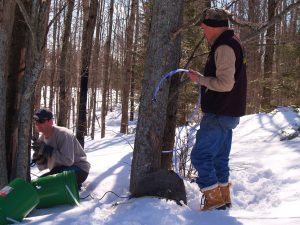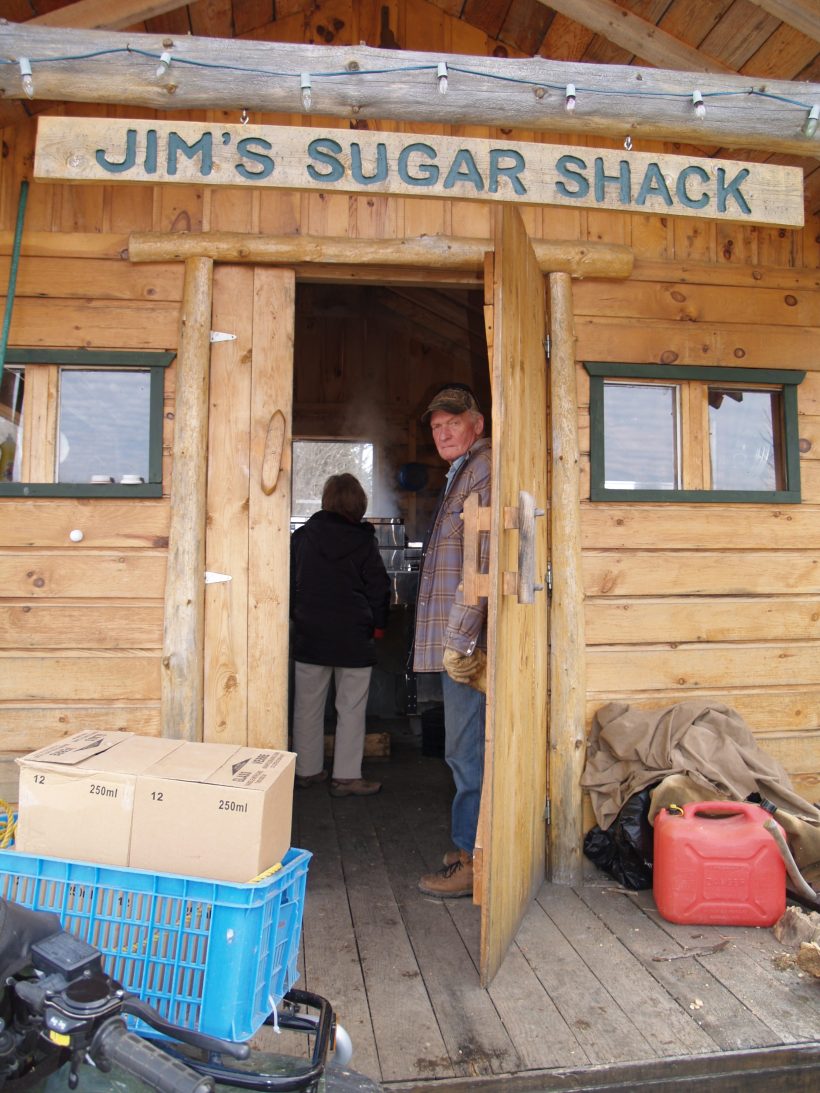
MAPLE SYRUP
Many years ago at school, we were told that the early explorers and settlers first discovered that the natives were making syrup from the sap of maple trees. There have been several suggestions as to how they discovered they could make a sweet substance by continuously boiling the sap until it thickened a bit. But since the Indians did not have any large pots or kettles until the white man arrived, I often got to wondering just how they managed to reduce a large quantity of sap to a much smaller quantity of syrup.
The spiles and the sap containers were easy. Again, when I was small, there were no sap buckets or the metal spiles we have today. The containers were a trough, made by splitting a basswood or poplar block, perhaps ten inches across. This split into two parts. Then it was simply hollowed out with an adz, or even just an axe. The spiles were made from a block of clear pine or cedar. A metal instrument called a gouge was used. This was a half or perhaps a quarter moon shape, about two inches across and maybe a foot long. The curved part only extended a short ways up the length of the shaft. It was fairly sharp, and after a few pieces were sliced off, the rest would come off with a nice curve at least at one end. Then the rest would be done with a jack knife, perhaps even a small trench the rest of the way to the other end. When it came to tapping trees, the bark would be smoothed off with a sharp axe, a cut made with the same tool that helped make the spiles and then the curved end of the spile would be lightly driven into the cut. Care had to be taken not to have the cut go into the wood as that would cause the sap to leak.
Sap was carried to the boiling place. The bucket was mostly one made of sheet iron and would hold perhaps twenty-five gallons. When the sap was boiling violently much of it would ‘boil over’, and this was a loss. So a piece of fat pork was fastened to the pail and it hung down just above the level of the sap. When the hot sap hit the fat meat it would cause a thin skim of grease to cover the sap, and like oil on troubled waters it prevented the sap from spilling.
As a small boy I can remember going with my father to help the man on a nearby farm get started with his syrup making. This man was one of the larger makers of syrup and his boiler was, I was told, a potash bucket or kettle. This was huge, perhaps weighed 200 pounds. I know it had to be handled with a long lever, which was a long slim maple. Watching them move the boiler with this method was always interesting.
When the first settlers came to this area, Kearney, they found the wooden sap troughs neatly turned over, on the place we will always know as Craig’s Hill. It is easy to understand why they would operate there as it is a nice maple bush and since it was high sap would run early. Noone in those days had to go far for maple trees.
We heard over the years theories about ways to get a better production of sap. Once I heard a college professor tell that areas where cattle pastured in the sugar bush for some reason produced more and better sap. Then so many times we hear that trees should be tapped close to the ground, and then some will tell you that they should be tapped as high as possible. And about packing the snow around the base of the trees.
Some years ago, Natural History magazine made a study over three years and came up with the facts that all that was needed was cool nights and warm sun to produce a good run of sap. They even cut down trees, cut them into lengths, stood them in water, and they produced sap. The trees were even inverted and stood with the tops in the water and it did not interfere with the flow of sap. And the quality of the sap was the same as when the trees were treated in the conventional way. How much sap for a gallon of syrup? Around 35 gallons is about right. Might vary a bit, but not much.
Methods of syrup making have changed so much with better results. It used to retail for $1.25 per gallon. In 1915 they raised the price a bit, to $1.35, and there was a lot of consternation. But cheap or expensive, the fact remains that maple syrup is just about one of the nicest tasting products that nature has provided for us.
